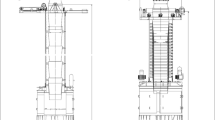Results from an experimental investigation of the aerodynamic drag of the slot leakages of a ventilation shelter are presented. Measures to reduce the flow rate of the air entering through a leakage by means of mechanical screening are proposed. The dimensions of screens that promote a reduction in the discharge of a ventilation system are found.











Similar content being viewed by others
References
I. N. Logachev, K. I. Logachev, and O. A. Averkova, “Methods and means of reducing the power requirements of ventilation systems in the transfer of free-flowing materials, “ Refractories and Industrial Ceramics, 54(3), 258 – 262 (2013).
I. N. Logachev, K. I. Logachev, O. A. Averkova, et al., “Methods of reducing the power requirements of ventilation systems. Part 1. Derivation of hydrodynamic equations of air ejection by a stream of free-flowing material in a perforated trough with bypass chamber,” Refractories and Industrial Ceramics, 55(1), 70 – 76 (2014).
I. N. Logachev, K. I. Logachev, and O. A. Averkova, “Methods of reducing the power requirements of ventilation systems. Part 2. Determining the efficiency of recirculating flows,” Refractories and Industrial Ceramics, 55(2), 164 – 168 (2014).
I. N. Logachev, K. I. Logachev, and O. A. Averkova, “Methods of reducing the power requirements of ventilation systems. Part 3. Design of loading device and suggstions for its improvement,” Refractories and Industrial Ceramics, 55(3), 265 – 260 (2014).
I. N. Logachev, K. I. Logachev, O. A. Averkova, et al., “Methods of reducing the power requirements of ventilation systems. Part 4. Theoretical prerequisites for the creation of dust localizing devices with swirling air flows,” Refractories and Industrial Ceramics, 55(4), 365 – 370 (2014).
I. N. Logachev and K. I. Logachev, Industrial Air Quality and Ventilation: Controlling Dust Emissions, CRC Press (Boca Raton) (2014), 417 pp.
O. A. Averkova, V. Yu. Zorya, I. N. Logachev, et al., “Numerical simulation of air currents at the inlet to the slot leakages of ventilation shelters,” Refractories and Industrial Ceramics, 51, No. 3, 177 – 182 (2010).
O. A. Averkova, I. N. Logachev, and K. I. Logachev, “Modeling flow separation at the inlet to the slot leakages of ventilation shelters,” Novye Ogneupory, No. 10, 56 – 60 (2012).
O. A. Averkova, I. N. Logachev, K. I. Logachev, et al., “Modeling detached flows at the inlet to round suction flues with annular screens,” Refractories and Industrial Ceramics, 54(5), 425 – 429 (2014).
I. N. Logachev, K. I. Logachev, V. Yu. Zorya, et al., “Modeling detached currents near a suction slot,” Vychislit. Metody i Programmirovanie, 11(1), 43 – 52 (2010).
I. N. Logachev, K. I. Logachev, and O. A. Averkova, “Mathematical modeling of detached currents at the inlet to a screened plane channel,” Vychislit. Metody i Programmirovanie, 11(1), 68 – 77 (2010).
I. N. Logachev, K. I. Logachev, and O. A. Averkova, “Mathematical modeling of jet flow of air at the inlet to a plane channel with divertor and impermeable screen,” Vychislit. Metody i Programmirovanie, 11(2), 160 – 167 (2010).
O. A. Averkova, I. N. Logachev, and K. I. Logachev, “Modeling of potential currents with unknown boundaries on the basis of stationary discrete vortices,” Vychislit. Metody i Programmirovanie, 12(2), 213 – 219 (2011).
O. A. Averkova, I. N. Logachev, and K. I. Logachev, “Modeling separation of flow at the inlet to suction channels in regions with slots,” Vychislit. Metody i Programmirovanie, 13(2), 298 – 306 (2012).
O. A. Averkova, I. N. Logachev, K. I. Logachev, et al., “The principles of separated flow at the inlet of the protruding duct with screens,” Uchen. Zapiski TsAGI, 44(2), 33 – 49 (2013); TsAGI Sci. J., Issue 2, 219 – 243 (2013).
I. E. Idel’chik, Handbook on Hydraulic Resistances [in Russian], 3rd ed., Mashinostroenie, Moscow (1992), 672 pp.
R. K. Veletskii and N. N. Grigina, Measurement of the Parameters of Dust and Gas Flows in Ferrous Metallurgy [in Russian], Metallurgiya, Moscow (1979), 77 pp.
The present study was carried out with the financial support of the Russian Foundation for Basic Research (Project No. 14-41-08005r_rfi_m) and the Council on Grants of the President of the Russian Federation (Project MK-103.2014.1).
Author information
Authors and Affiliations
Corresponding author
Additional information
Translated from Novye Ogneupory, No. 4, pp. 56 – 61, April, 2015.
Rights and permissions
About this article
Cite this article
Logachev, K.I., Khodakov, I.V. & Averkova, O.A. Decreasing the Power Requirements of Ventilation Shelters Through Aerodynamic Screening of Slot Leakages. Refract Ind Ceram 56, 204–209 (2015). https://doi.org/10.1007/s11148-015-9814-4
Received:
Published:
Issue Date:
DOI: https://doi.org/10.1007/s11148-015-9814-4




